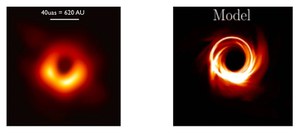Imaging a Supermassive Black Hole
 The direct imaging of a supermassive black hole (SMBH) event horizon at the heart of the galaxy Messier M87 by the Event Horizon Telescope (EHT) was an extraordinary scientific achievement, the culmination of years of effort by an international team, in collaboration with NRAO staff, to perform submillimeter Very Long Baseline Interferometry (VLBI) observations at the ultra-high angular resolution of 20 microarcseconds.
The direct imaging of a supermassive black hole (SMBH) event horizon at the heart of the galaxy Messier M87 by the Event Horizon Telescope (EHT) was an extraordinary scientific achievement, the culmination of years of effort by an international team, in collaboration with NRAO staff, to perform submillimeter Very Long Baseline Interferometry (VLBI) observations at the ultra-high angular resolution of 20 microarcseconds.
ALMA was vital to this research: without the ultra-sensitive phased ALMA, these observations would have been impossible. The ALMA phasing project was funded in-part through the ALMA development program.
A defining feature of the images of radio emission at the heart of galaxy M87 is an irregular but clear bright ring, whose size and shape agree closely with the expected lensed photon orbit of a 6.5 billion solar mass black hole. Soon after Einstein introduced general relativity, theorists derived the full analytic form of the photon orbit, and first simulated its lensed appearance in the 1970s. By the 2000s, it was possible to sketch the "shadow" formed in the image when synchrotron emission from an optically thin accretion flow is lensed in the black hole's gravity. During this time, observational evidence began to build for the existence of black holes at the centers of active galaxies, and in our own Milky Way. In particular, a steady progression in radio astronomy enabled VLBI observations at ever-shorter wavelengths, targeting SMBHs with the largest apparent event horizons: M87, and Sgr A* in the Galactic Center. The compact sizes of these two sources were confirmed by studies at 1.3mm, first exploiting baselines from Hawai'i to the mainland U.S., then with increased resolution on baselines to Spain and Chile.
Over the past decade, the EHT extended these first measurements of size to mount the more ambitious campaign of imaging the shadow itself. In April 2017, the EHT observed M87 on four days using an array of eight radio telescopes at six geographic locations: Arizona (USA), Chile, Hawaii (USA), Mexico, the South Pole, and Spain. Years of preparation and fortuitous planet-wide good weather yielded a multi-petabyte dataset. The results presented here, from observations through images to interpretation, issue from a team of instrument, algorithm, software, modeling, and theoretical experts, following a tremendous effort by a group of scientists that span all career stages, from undergraduates to senior members of the field. More than 200 members from 59 institutes in 20 countries contributed.
The final images emerged after a rigorous evaluation of traditional imaging algorithms and new techniques tailored to the EHT instrument – alongside many months of testing the imaging algorithms through the analysis of synthetic data sets.
The resultant image of the shadow confines the mass of M87 to within its photon orbit, providing the strongest case for the existence of SMBHs. These EHT observations are consistent with Doppler brightening of relativistically moving plasma close to the black hole lensed around the photon orbit. They strengthen the fundamental connection between active galactic nuclei and central engines powered by accreting black holes through an entirely new approach.
More than 200 members from 59 institutes in 20 countries and regions have devoted years to the effort, all unified by a common scientific vision. This historic result provides perhaps the ultimate verification of strong-field general relativity and signals the development of a new field of research in astronomy.
IMAGE: [Left] EHT 230 GHz image of the M87 black hole event horizon. [Right] Model for the General Relativistic shadow caused by the severe space-time bending around the Schwarzschild radius, seen as a bright ring with a dark center, indicating the radius of the orbits of the last photons able to escape the extreme gravitational field of the 6 x 109 M⊙ black hole (EHT Collaboration: Akiyama, Kazunori et al., 2019).
Publications
Focus on the First Event Horizon Telescope Results
Astrophysical Journal, 875, L1 (10 April 2019)
Event Horizon Telescope Collaboration: Akiyama, Kazunori (NRAO, Haystack Observatory, National Astronomical Observatory of Japan, Harvard University) et al., First M87 Event Horizon Telescope Results.
NRAO Press Release: Radio Astronomy and Black Holes




Connect with NRAO